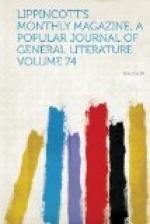In this departure from the retired hamlet of Mbuyapey our traveler falls into the great highway that passes through the Missiones between Asuncion and Encarnacion on the Parana, in the south-eastern corner of Paraguay. It includes in its extent the towns and villages of Jesus, Yuti, Ibicuy, Quindi, Carapegua and Paraguari. The road presents a busy scene, for it is along this route that the troperos drive their herds of cattle obtained from the Argentine province of Corrientes, on the other side of the Parana. These drovers are free livers, and they spend their money lavishly in the villages. The aspect of the Missiones differs from the part of Paraguay lying to the north of it, as the names of the villages in the province differ from the nomenclature elsewhere. Pampas covered with water prevail, for the country south of the Tebicuari is generally marshy, and during a part of the year is transformed into a lake. Throughout this region decay and ruin have set their seal on what was formerly one of the most prosperous parts of the republic. Orange trees grow in wild profusion on the spots where once stood farm-houses, while mud ranchos, tenanted by a few old women who sustain life with oranges and manioc, here and there disturb the monotony of desolation. The early Jesuits have left their traces in their churches, college squares now empty, and houses gone to wreck, while their labors in the cause of religion and civilization are recalled in the names of saints borne by the villages. At Carapegua, which owes what importance it possesses to its proximity to Paraguari and the railroad, our traveler once more finds himself amid the products of civilization, for on the shelves of the grocery stores are displayed, among other wares, cans of preserved fruits and meats from Europe.
From Carapegua, M. Forgues journeys to Paraguari, a day’s ride. Eight days later he is in Asuncion, and ready to take passage on the Republica for Buenos Ayres. “From the preceding extracts,” he writes, “a very exact idea may be formed of a journey in the interior of Paraguay at the present time. How to procure a piece of bread is a matter of serious moment: riding on horseback fifteen leagues at a stretch, or threatening to blow out somebody’s brains, is, as it were, a matter of daily occurrence. What is seen and done there is often monstrous compared with our European customs, and yet is not even shocking there where it is seen and done.”




